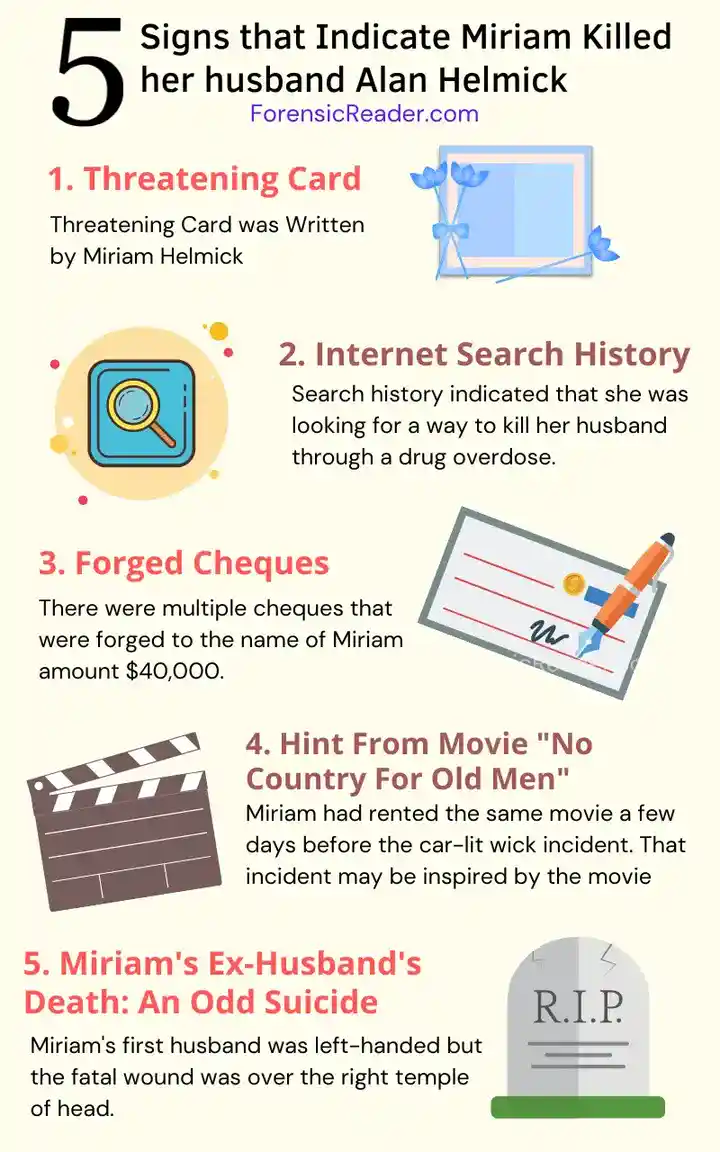A real estate businessman, Alan Helmick was killed in his house. There were bullet shells, greeting cards, and forged cheques as evidences but none of them help more than a 20-year bullet was fired by Alan Helmick’s father.
Seems interesting? Let’s look into the case and find out what happened to Alan Helmick and his wife Miriam Helmick. Season 14 episode 16 of forensic Files.
How Alan Helmick Died? (Full Summary of the Gone Ballistic Case)
In 2008, Alan Helmick, a real estate developer in Colorado had many enemies. One day, he was waiting for his wife Miriam in the parking lot where his car caught fire by a light wick. Luckily, he escaped the car safely as soon he noticed the fire.
Six weeks later, Alan and his wife Miriam were supposed to meet for lunch. When Alan did not show up for lunch, she called him. He didn’t respond, so she went home where she discovered that Alan was shot dead on the floor.
The crime scene (cs) was disturbed that looks like a robbery but later finding stated that it wasn’t. Someone from his family or known killed Alan Helmick.
Later, forensic evidences such as computers, a greeting card, shop CCTV, and a 20-year-old bullet helped investigators to find that family member.
Let’s dig deeper and study the case in more detail.
Who Was Alan Helmick, his Wife Mirian Helmick, and Family?

- Alan Clarke Helmick: A wealthy real estate agent in Colorado, USA.
- Miriam Giles: Wife of Alan Helmick, a dance instructor.
Alan and Miriam Relationship: After losing his first wife to a sudden heart attack, Alan Helmick (54) remarried two years later to Miriam Giles in January 2005.
Both began a new life in Colorado and had a loving relationship. Alan bought everything Miriam wanted and kept her happy. However, due to the financial crisis, the couple faced some difficulties.
Why did Police believe It was Not a Robbery Killing?
Seems like Robbery: At first, it seems that it was a robbery. Some of the valuable items were missing and the house looks distorted. More preciously, several drawers and a jewelry box were empty.
Why did Police believe it was not a Robbery Killing? The main reason was that there was no forceful entry. This means the robber was known to Alan or had access to keys.
Another reason is that other parts of the house remain untouched, indicating that not seem like a possible burglary case that resulted in Alan’s death. This indicates that it was planned or staged to appear as a robbery.
Note: Difference Between Burglary and Robbery
Both are associated with the stealing thing but in different situations. Burglary means entering the building usually when no one is present in the building. It can also be called to crime against a building or thing.
On the other hand, Robbery is a more serious crime than burglary that involves forcing the victim while steal. It can also be called a crime against a person.
So, let’s assume, Alan was not at home (or no one was at home), then it can be called a crime against a building or thing, or burglary.
How is Robbery Different from Planned Homicide? What are the signs?
| Features | Sign of Robbery | Sign of Homicide |
|---|---|---|
| Entry | Force entry | May or may not be forced entry |
| Motive | Stealing | Killing |
| Fabrication | No sign to hide | Try to fabricate as a robbery |
| Known/Unknown | Usually not know to victim | May or may not be known to the victim |
| Physical Crime Scene | Theft of valuable items, damage, and distorted property | Clean crime scene/staged |
| Victim | Physical violence (usually not murder) | Physical acts with intent to kill not just harm. |
Why Was Alan’s Wife Miriam Helmick Initially Removed from Suspect List and Then Reintroduced?
Following are the reason why Miriam Helmick was on the suspect list (and also why she was first released).
A. Reason Why Miriam Released from Suspect List
GSR Analysis: Because Alan was shot with a 25-caliber gun, the culprit should have gunshot residue over their hands and face. As Miriam was the first to appear at cs, she was also a suspect. However, the GSR analysis rules out the possibility of her involvement in the murder.
B. Signs that Indicate Miriam Killed her husband

1. Threatening Card
A week later the funeral of her husband, she found a greeting card with no post stamp under the front doormat. The letter had no fingerprints or envelope (for saliva)— just a greeting-cum-threatening card.
It was addressed “To the GREVING WIDOW” i.e. Miriam.

The threatening card was handwritten. It was studied by forensic questioned document experts but can’t find any conclusive observation to suspect because (1) it was disguised writing, and (2) only capital letters were used.
As the letter has no post stamp it means it was hand-delivered. Police tracked down the manufacturer and the shop where it was purchased.
Luckily, the shop had a CCTV camera that identified the buyer (Miriam Helmick) of that greeting card. She purchased it from the shop (13 miles from her house), four days before the card was discovered.
2. Internet Search History
Investigators confront the home computers after discovering that Miriam purchased the threatening card herself. There were two computers, one for Alan and the other for Miriam.
Police investigators the hard drives and internet search history and found some more suspicious clues. She was searching for a drug overdose, especially from the drug prescribed to Alan such as Ambien, Viagra, and Alcohol.
The search indicated that she was looking for a way to kill her husband through a drug overdose.
3. Forged Cheques and Money
Investigators began looking into Miriam’s background and discovered that she was the beneficiary of her ex-husband Jack Giles’s $100,00 life insurance policy.
Investigators were now looking for Alan’s accounts and discovered multiple cheques totaling $40,000 made out to Miriam that were possibly signed by Alan.
According to forensic examiners, about a dozen (10) of the cheques were forged. However, they can’t conclusively state who was the forger.
4. Hint From Movie “No Country For Old Men”
During the investigation, police suspected that Miriam was also behind the six-week-old attempt to kill Alan with a lit wick.
Investigators recalled the movie “No Country For Old Men,” in which a villain blows up a car with a lit wick. Investigators were now wondering if Miriam had seen the movie.

They discovered, that Alan and Miriam had rented the same movie a few days before the car lit wick incident.
5. Miriam’s Ex-Husband’s Death: An Odd Suicide
In 2002, Jack Giles, Miriam’s first husband, committed suicide with a gun to his right temple while Miriam was sleeping on another side of the bed. The case was closed as suicide.
While investigating Miriam’s past, police recheck the case and discovered that Jack was left-handed. This raises the question, “Why did he shoot himself with his right hand?“
Later, police thought it was also a murder but Miriam was only charged for the Alan murder. And Jack’s case remains suicide.
Why did Miriam Helmick Kill her Husband Alan?
The two main motive of Miriam for killing Alan Helmick was his money and revealing the truth about her forgery.
Motive 1: Money: Alan had a huge money sum of capital such as money, bonds, and properties. There were multiple cheques that were named out on Miriam.
Also, her ex-husband Jack who was a life insurance policy of $10,000 fetched by Miriam after his death. This proposed a theory she might kill her husband for their money.
Motive 2: Miriam suspected Alan Helmick Knows about Forged Cheques: There were numerous cheques that were named to Miriam. After a forensic examination, it was discovered that they were forged, but they could not be proven to be made by Miriam.
So, it is another theory Miriam was the forger, and Alan eventually learns about it. And, in order to cover up the forgery, she might killed Alan.
Read More: Shoot to Thrill Case Study: Forensic Approach to Ken MacLennan’s Death
First Husband: Suicide or Homicide? What Evidence Finds Police Objectionable to Suicide of former huband of Mirian Helmick?
There were two possible reasons why police even considered his first husband’s case as homicide by Miriam.
Theory 1: Motive Seems Same
One of the theories was that she killed Alan because of his money. There were multiple cheques named out to Miriam and some of them were proven to be forged. Jack also had life insurance that was quickly collected by beneficiary Miriam. So, the police thought that like Alan, she killed her former husband.
Theory 2: Jack Was Left-Handed
Jack Giles was known to be left-handed. However, the autopsy reveals that the gunshot entered through the right side of his head which means his right hand pulled the trigger.
These two reasons point out that Jack Giles was murdered by his wife. But again, the case was closed as suicide because there was no additional evidence linking Miriam to the murder of her ex-husband.
Read Similar Case: Patrick Walsh & Pamela Sweeney [Flower Power] Forensic Files Case Study
How Did 20-Year-Old Bullet Help to Solve Alan Helmick Case?

Alan’s family had an heirloom gun which went of missing after Alan’s death. The police suspected that Miriam might use the same family gun to kill Alan Helmick.
But, without the weapon of crime or evidence to establish the link, police were helpless. Wendy, Alan’s daughter, then told police about a 20-year-old domestic dispute between her grandparents involving the same family gun.
On a night in 1989, Wendy’s grandfather tried to shoot her grandmother, but a neighbor intervened and try to stop him. In doing so, the trigger was pulled, and the bullet went into the lawn where their grandparents were fighting.
Using ground penetrating radar, forensic analysts were able to find that 20-year-old bullet buried in the soil. The bullet was highly corroded but have visible land and grooves marking.
After that, the bullet from Alan’s head was compared with the 20-year-old corroded bullet. Both the bullets have similar land and groove impression and their widths was a right-hand twist bullet
Based on findings, the forensic expert concluded that both the bullet could have been fired from the same firearm. It was enough to hold Miriam for the charge of crime since she was the only one who has easy access to that handgun.
Forensic Analysis that Helps Gone Ballistic Case and catching of Merian Helmick
Following are the test and forensic analysis that was employed in the case.
1. GSR Examination
Gunshot residue (GSR) analysis detects the presence of a powder discharge from shooting a firearm. The main constituents of primer discharges are lead (Pb), barium (Ba), and antimony (Sb).
Some common tests for GSR examination are:
- Paraffin test (used for skin surface but nonspecificity)
- The Harrison-Gilroy test (test for primer charge and more specific than paraffin)
- Scanning electron microscopy (SEM) (majorly GSR on clothing)
- Case: Chemical test for GSR from the swaps from Miriam was Negative.
- Possible reasons for negative GSR test:
- She bathed after shooting
- Wear full-sleeves clothing
- Used gloves
2. Shell Casing
Shell casing holds the primer charge, propellant, and bullet in one case. It is also called a cartridge case.
Case: A shell case was found at a crime scene. Headstamp analysis revealed that it was a cartridge case for a 25-caliber handgun that could be originated from the same 25-caliber pistol that Alan Helmick inherited from his parents.

3. Bullet Matching
The two bullets: one from the crime scene and another 20-year-old from the lawn were matched side by side using a comparison microscope. Land and groove patterns and striation marks on bullets were matched. Forensic Ballistic experts stated that both could be fired from the same firearm.
4. Greeting Card Writing
Greeting Card that was found on the doormat doesn’t have any postal stamps, envelope, or fingerprint.
Without postal stamps, it becomes harder to trace the origin which also means it was hand-delivered. Without an envelope, the chance of getting crucial saliva or DNA evidence was minimized.
For the development of fingerprints on paper, magnetic powder is commonly used. As greeting cards usually have a colorful design, one of the best methods for improving contrast is to use powder fluorescent methods.
So, ruling out all three (postal stamps, envelope, and fingerprints), only handwriting analysis was the option. Following are the observation of the forensic handwriting analysis of the greeting card.
- Full of spelling mistakes.
- Only capital letters were used.
- Fast and slow writing (a sign of disguise writing).
- Increased and decreased font sizes (a sign of disguise writing).
- Exaggerated slant of writing (a sign of disguise writing).
5. CCTV at Store
Most of the cameras at stores or homes have IR-based sensors. This makes it even easy to see in night light. The footage usually is black and white or mono color.
Case: Police contacted the greeting card manufacturer, who informed them that those cards were sold in three stores. One of the stores was only 13 miles from Alan’s house.
Fortunately, the store has a CCTV camera. The CCTV footage showed Miriam herself bought the card, four days before she told police that she found the card in front of the house doormat. Police confronted her with CCTV footage, and in her defense, she stated that the card was set by her to make authorities take the case seriously.
6. Computer and Hardware
When you search for something on the internet using a browser on any electronic device, it will be saved on the computer as a cache. These cache files are stored in hard drives unless you’re using incognito mode. There are various forensic tools to extract digital data from the device.
Case: On forensic analysis of Miriam’s computer, it was found that she was searching for methods to overdose on the medication Alan had been prescribed. Police believed that she was finding a way to kill her husband.
7. Forged Cheques
Cheques are typically forged with signatures, writing inks, and alteration (usually addition) amounts. As cheques have limited writing, it becomes harder to state who forged the signature, even if a possible suspect writing sample is available for comparison.
Case: There are numerous cheques paid out to Miriam. According to the forensic document examiner, ten cheques were forged. However, authorship was not conclusively determined or traced back to Miriam.
Punishment Miriam Helmick Received For Killing Alan
- Arrested: On November 8, 2008, Mirima Helmick was arrested in Florida for the charge of murder of her second husband Alan Helmick.
- Trial Ended: In December of 2009, all the jury members identified Miriam as a liar and found her guilty of killing her husband. The judge charged her with first-degree murder.
- Punishment: She was sentenced to life plus 108 years imprisonment.
Watch it on Youtube Forensic Files Channel: Gone Ballistic
Read More:
- Reel Danger [Stenger’s Pond Attack] Case Study: Forensic Files, Diatoms, Evidence, And Culprits
- Offensive Vs Defensive Wounds: Forensic Injuries & Medico-Legal Importance
- Second Shot at Love: Killing of Darryl Sutorius Case Study | Forensic Files
- Trey Cooley [The Magic Bullet] Case Study: Forensic Files, Culprit

FR Author Group at ForensicReader is a team of Forensic experts and scholars having B.Sc, M.Sc, or Doctorate( Ph.D.) degrees in Forensic Science. We published on topics on fingerprints, questioned documents, forensic medicine, toxicology, physical evidence, and related case studies. Know More.

Pingback: Todd Kohlhepp [Serial Killer Case Study] #Victim, Pattern, Motive, Signature